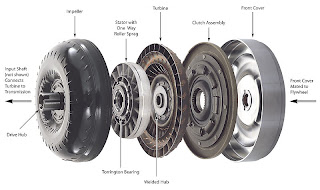comonent parts
first we disassembling the manual transmission
selector lever
selector lever is there which you can selects gears by moving the shift rails and forks
forks and shift rails
The forks and shift rail are used to select the gear when you change gears, it is loacted internals of the transmission housing inside the detents to the synchromesh sleeve.



interlock
a metal interlock prevents the two shift forks from moving, the interlock also prevents the finger from selecting a gear if any of the shift rails is moved from the neutral position.

detent
the detent is a hardened steel ball and spring like the picture it against a groove or dent in the shift rails shown in the picture. it keeps the tramission in gear and lets the driver know that a gear has been selected.
gears uses in manual transmission
Helical gears teeth are cut in an angle, when the two teeth on the helical gear engane it starts at one end of the tooth and gradually spreads as the gears rotate. most gears in the manual transmission have helical type of gears
Spur gears is very common type of gears, the teeth on them are stright and are mounted on a parallel shafts. many spur gears are used at once to make a large gear reductions. the spur gears are cheap to make and can be really loud also it increases the stress on the gears teeth.
the parts of the synchromesh unit are
- baulk ring
- insert spring
- inserts
- hub and sleeve alignment marks
- sleeve
why you need a sychromesh in a tramsmission is because when your changing gears the synchromesh parts synchronizes slow down the speed of the gearr being selected with the input shaft. the avaertgest is that it easy gear shifting, faster gear shifting and reduce damage to the engaging teeth of the gears
Shafts in manual transmission
input shaft - its connect to the clucth to the output stright through to the gearbox
reverse and idler shaft - the idler drives the mainshaft this gear changes the direction of the rotation of the gears to provide reverse.
mainshaft - its transmit drive through the dog teeth gears which carries the drive to the driveshaft
Countershaft - this connects input and output shaft thats is driven from the main shaft rotates the opposite rotation to the input shaft
bearing
taper rolling bearings
needle roller bearings
vertical needle roller bearings
GEAR RATIO
to a speed ratio as opposed to a torque ratio
GEAR RATIO = TEETH IN DRIVEN GEAR / TEETH IN DRIVING GEAR




























